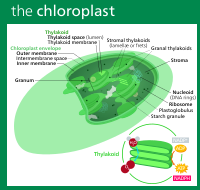
Photo from wikipedia
Plastids are sites for carotenoid biosynthesis and accumulation, but detailed information on fruit plastid development and its relation to carotenoid accumulation remains largely unclear. Here, using Baisha (BS; white-fleshed) and… Click to show full abstract
Plastids are sites for carotenoid biosynthesis and accumulation, but detailed information on fruit plastid development and its relation to carotenoid accumulation remains largely unclear. Here, using Baisha (BS; white-fleshed) and Luoyangqing (LYQ; red-fleshed) loquat (Eriobotrya japonica), a detailed microscopic analysis of plastid development during fruit ripening was carried out. In peel cells, chloroplasts turned into smaller chromoplasts in both cultivars, and the quantity of plastids in LYQ increased by one-half during fruit ripening. The average number of chromoplasts per peel cell in fully ripe fruit was similar between the two cultivars, but LYQ peel cell plastids were 20% larger and had a higher colour density, associated with the presence of larger plastoglobules. In flesh cells, chromoplasts could be observed only in LYQ during the middle and late stages of ripening, and the quantity on a per-cell basis was higher than that in peel cells, but the size of chromoplasts was smaller. It was concluded that chromoplasts are derived from the direct conversion of chloroplasts to chromoplasts in the peel, and from de novo differentiation of proplastids into chromoplasts in flesh. The relationship between plastid development and carotenoid accumulation is discussed.
Journal Title: Molecules
Year Published: 2019
Link to full text (if available)
Share on Social Media: Sign Up to like & get
recommendations!